

Mentor Team
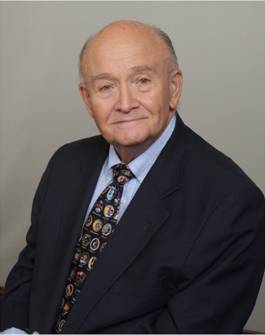
Norman Chaffee
Education Outreach Consultant of NASA Education Office
Co-Owner/Founder of Atlantis Educational Services, Inc., Titusville, Florida
Norman Chaffee
the Competition Coordinator for ISSDC since 1999
Served various positions in the NASA Propulsion and Power Division for over 20 years
the former chief Engineer for Technical Program Systems Integration and International Space Station Program
Former chairman of Houston Chapter of American Institute of Aeronautics and Astronautics.
Former president and director of Parkview Estates Community Association.
Manager of JSC Annual Space Settlement Design Competitions for over 20 years.
Invention Award of NASA Johnson Space Center in 1977
NASA Outstanding Leadership Medal in 1993
NASA Exceptional Public Service Medal (Education) in 2007
Texas Department of Education Heroes of Children Award in 2008
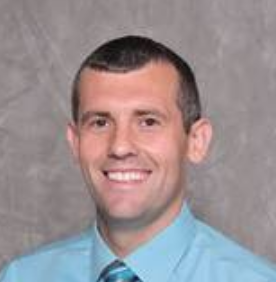
Jordan Menning
an education consultant for the state of Iowa
a national STEM trainer
a leader in STEM education
Jordan Menning is an education consultant for the state of Iowa. He has helped implement STEM Education across the United States and is a national STEM trainer to bring real-world learning experiences to students around science, technology, engineering, and math, which includes Space Settlement Design Competitions. Jordan is a leader in STEM education and has spoken at many conferences throughout the United States. He has a Bachelors of Science Degree, a Masters of Science Education, and a Specialist Degree in Education Leadership.
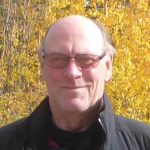
Dr Randall Perry
SSEF & SDC Founder
Senior Research Investigator Imperial College London, Royal Society Fellow and University of Oxford Fellowship
Dr. Perry is the founder of the UKSDC and Space Science Engineering Foundation a UK charity. He is currently the Honorary Chair of the SSEF and a Senior Research Investigator and a past Royal Society Research Fellow based at Imperial College London. He has a B.S., M.S. and Ph.D. from the University of Washington, has held the US and Canada National Science Foundation Fellowship at Oxford University, and has a NASA certification in Astrobiology. In addition to this, he has published widely in his areas of interest of geology, geochemistry, microbiology and education and he has collaborated with Dr. Catherine Fosnot on whose learning methods the Space Design Competitions are based.
Dr Perry was shortlisted for a Sir Arthur Clarke Award in 2013 for his work on USKDC.
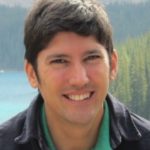
Dr Richard Ghail
SSEF Trustee Chair
Lecturer in Engineering Geology, based in the Department of Civil and Environmental Engineering, Imperial College London
Richard Ghail is Lecturer in Engineering Geology, based in the Department of Civil and Environmental Engineering, with research interests in The London Basin Forum, Intraplate Processes and the Neotectonics of Great Britain, Plate Tectonics of Buoyant Lithospheres and EnVision.
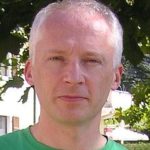
Marcus du Sautoy FRS, OBE
Simonyi Professor for the Public Understanding of Science and a Professor of Mathematics at the University of Oxford
Dr. Sautoy is currently SSEF and SDC patron. He is the Simonyi Professor for the Public Understanding of Science and a Professor of Mathematics at the University of Oxford. Formerly a Fellow of All Souls College, and Wadham College, he is now a Fellow of New College. He was previously President of the Mathematical Association, an EPSRC Senior Media Fellow and a Royal Society University Research Fellow. His academic work concerns mainly group theory and number theory. In October 2008, he was appointed to the Simonyi Professorship for the Public Understanding of Science, succeeding the inaugural holder Richard Dawkins.

Dr. Elizabeth Luthman
Integral part of the original founding team for the SSEF
PhD in hypersonics
Work at California Institute of Technology (CALTECH) and JPL.
Liz first became involved with the Space Competition in 2010 as a technical expert in Space Structures. She was an integral part of the original founding team for the SSEF. She graduated from the University of Bristol in 2007 with an MEng in Aerospace Engineering and has spent the last three years as an aeronautics researcher at Imperial College. Her PhD was in hypersonics (very high speed aerodynamics). She is currently at California Institute of Technology (CALTECH) and JPL.
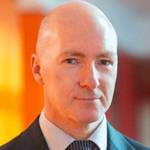
Professor Mark A. Sephton
Head of the Department of Earth Science and Engineering, Imperial College London.
Professor Mark A. Sephton is Head of Earth Science and Engineering at Imperial College London. He is a University Geochemist and Planetary Scientist with a substantial record of discovery and innovation. His research and teaching include the subject areas astrobiology, space missions, meteorites, forensic science, Earth systems and petroleum. He has a track record of fund raising, management, publication, education and media communication. His work has attracted awards and international recognition. He has held senior leadership positions and international committee roles, the latter often with NASA and ESA.
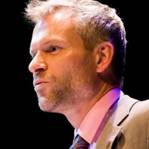
Jeremy Curtis
Head of Education and Skills,UK Space Agency
Jeremy Curtis leads the UK Space Agency’s space education programme, which uses space to inspire interest in STEM subjects as well as addressing the skills needs of the growing UK space industry. A major focus of the programme has been the package of education activities in support of Tim Peake’s mission to the ISS, which were taken up by over 2 million young people. They are now working to widen the programme to cover the range of UK space activities from space launch to Mars exploration and applications on Earth. In 2017 he was awarded an honorary Doctorate of Sciences by Queen Mary University of London. Jeremy chairs the Space Education Office (ESERO-UK) Steering Group and is a member of the steering group of the National Space Academy.
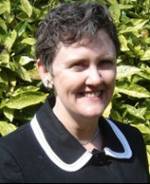
Alison Ahearn
Deputy Director Galactic Challenge
Principal Teaching Fellow at Imperial College London
Alison Ahearn is a Principal Teaching Fellow at Imperial College London, teaching undergraduates and postgraduates in civil engineering law and management. At College level, she works with the Educational Development Unit on teacher-development and the formalising of systems for recognising the learning achieved by students outside the classroom.
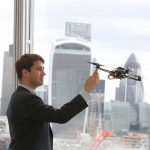
Adam Braithwaite
Adam completed his Master’s degree in Aerospace Engineering at Imperial College in the summer of 2015, and is now a quantitative strategist at Goldman Sachs focused on pricing and modelling of derivative products across the securities business. In his scarce free time, he enjoys flying, scuba diving, and stealing unattended pizza at the competition finals. Adam was the UKSDC organising chair for 2013/14.

Dr. Helen Oliver
Helen Oliver is a Research Associate in the Networks and Operating Systems Group at the University of Cambridge Computer Laboratory. She has been volunteering as a Judge and Technical Expert with the UKSDC since 2011, when she was working in the Design Engineering Group at Imperial College London. She has been a Judge at the International Finals at both NASA Johnson and NASA Kennedy. She is the original developer of designVUE, a concept mapping software application for capturing design rationale which was subsequently used in a project at NASA Ames to analyze a case study of system failure. Her current research interests include the Internet of Things, personal data stores and privacy by design, and wearable technology.
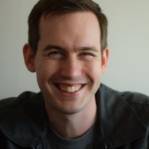
Scott Fisher
Scott Fisher is an Opto Mechanical Engineer Surrey Satellite Technology Ltd.
Scott Fisher is an Opto-Mechanical Engineer currently working at Surrey Satellite Technology Ltd (SSTL), UK, where he develops optical payloads for Earth Observation Satellites. He previously worked as a Mechanical and Aerospace Engineer at Insitu Pacific Ltd, Australia, where he designed payloads and platforms for Small Unmanned Aerial Systems (sUAS). Scott graduated with an Honours Degree from The University of Queensland, Australia, and has completed the International Space University’s Southern Hemisphere Summer Space Program. He is a Chartered Member of the Institute of Mechanical Engineers (IMechE). Outside of work, he is an active proponent for Science Technology Engineering and Maths (STEM) education and outreach, and frequently volunteers his time with the IMechE and the UK Space Design Competition.

Louis Lyle
Louis recently finish a degree in Mathematics and Statistics at the University of York and is the Finance Director for BAFTA, London. He has been involved in the SDC competition since 2011. He was the head of the Human engineering section of the winning team in 2014 and was one of the twelve chosen to represent the UK at the international final in Florida. Louis has since volunteered for both the 2015 and 2016 competitions and has held a number of roles varying from technical specialist, to judge, to CEO at last year’s final.
More experts to be updated
Training Courses
International Space Settlement Design Competition Learning Workshop
The Background:
How big the imagination of mankind in the space world, and how strong our next generation’s curiosity about the unknown world requires more people to devote themselves to scientific research and popular science. This course is designed to improve the leadership,team cooperation ability, art, design skills (planar, 3D design), computer basic skills, mathematical operation ability , architectural planning skills, English (writing, speaking) skills.At the same time ,the trainees also have the business acumen and cultivate the spirit of research. They are also quite business-minded and motivated, and are committed to exploring the space life sciences and promoting the practical and international development of China's youth aerospace science.
The main content of the course revolves around the following aspects:
Structure: Overall structural design, functional zoning and building materials of the space station Operation: Basic support for the construction and operation of space stations, such as transportation
Automation: Design automation equipment required for space station operations
Habitat: Space station interior design, including urban planning, etc.
Commercial development: designing commercial operations to make the space station profitable
Faculty:
Ph.D. in Physics, Aerospace, Computer, Information Technology, Automation, Structural Engineering, etc.
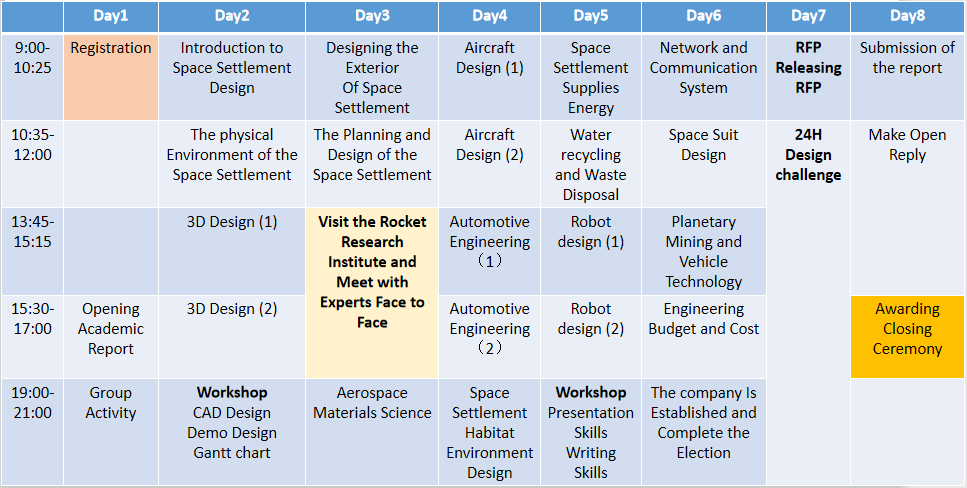
Introduction to Space Settlement Design
Main content: Describe the main ideas of space city design, including structural design, external configuration, material selection, community environment, energy system, construction, automation, vehicle design, etc., and a general overview of the knowledge system.
The physical Environment of the Space Settlement
Main content: To tell the different physical environments of the space world. From the moon, Mars, and close-range orbits, analyze the physical environment of space, including atmospheric composition, temperature, radiation, gravitational value, electromagnetic environment, and mineral environment. Compare and analyze the global environment to understand the physical environment challenges facing the construction of space cities.
3D Design
Main content: Space settlement planning and design, vehicle, aircraft design, etc. Needs to use 3D modeling software. Teaches the functions of 3D modeling basic software, and the actual operation of some specific design models.
Workshop
Main content: simple design of CAD software, presentation skills, the use of the Gantt chart of the schedule.
Designing the Exterior of Space Settlement
Main content: According to the specific number of people, it is proposed to build a space settlement suitable for 10,000 people. Considering the physical environment of space, the overall shape, size, functional division and connection area of the whole city are planned and designed. Professional direction: architectural design.
The Planning and Design of the Space Settlement
Main content: Taking the human-inhabited city as the core, the regional rational planning of the whole city, including living area, residential area, entertainment area, energy source area, waste treatment area, planting area, setting the capacity and area of the partition according to the population and size. Professional direction: urban planning.
Aerospace Materials Science
Main content: Basic science in the classification of aerospace materials. Contains the material composition, physical and chemical characteristics , price, application scenarios, access to raw materials, basic processing procedures, such as silicon, aluminum, nano, carbon fiber and other materials. Professional direction: major in physics and chemical materials.
Aircraft Design
Main contents: design the aircraft according to the requirements of the space city, including the passenger interplanetary travel aircraft and industrial mineral transport aircraft. It involves the appearance, carrying volume requirement, safety, power source and cost of aircraft. Major: aircraft design.
Main content: The design of the aircraft in conjunction with the needs of Space City, including passenger interstellar travel aircraft, industrial mineral transport aircraft. It relates to the appearance of the aircraft, the bearing capacity requirements, safety, power source and cost. Professional: Aircraft design.
Automotive Engineering
Main contents: selected several automation application scenes of space city. Automatic connection design of aircraft and urban main body, automatic watering, harvesting and processing of plant planting, dust removal and cleaning of main city and automatic protection and early warning system, etc. To teach the principle, design and application of automation devices. Major: automation.
Main content: Select several major automation application scenarios in Space City. Automated connection design of aircraft and urban main body, automatic watering, harvesting, treatment of planting, dust removal and cleaning and automatic protection early warning system for main city. Teaching the principles, design and usage scenarios of automation devices. Professional direction: automation.
Space Settlement Habitat Environment Design
Main contents: the design ADAPTS to different urban population types of living space, such as couples living space, single living space, children living space, including community design, residential design and safe access environment. The professor measured the area with basic mathematical calculations. Major: residential environment, urban planning and design, etc.
Main content: Designing living spaces suitable for different urban population types, such as a couple living space, single living space, children living space, including community design, residential design and safe access environment. The professor measures the area using basic mathematical calculations. Professional direction: related professions such as human settlements, urban planning and design.
Space Settlement Supplies Energy
Main content: According to the environment of the space settlement, several energy solutions are proposed. Nuclear energy, solar energy, bioenergy, wind energy, electromagnetic energy, etc., are used for the supply of urban energy systems. The relationship between the size of the energy base construction and the number of people covered. Professional direction: major in physics, chemistry and energy.
Water recycling and Waste Disposal
Main content: Design the main water circulation system based on the appearance and habitat of the space settlement, including the construction of the water source base, the laying of the main pipeline, the access and discharge of drinking water and sewage, the recycling and treatment of human domestic waste and recycling application. Professional direction: water supply and drainage engineering, sewage treatment, energy and other professional.
Robot Design
Main content: The operation of a space settlement requires a lot of robots. Several scenarios are presented for robot design. Such as mining robots, plant planting robots, human service robots, equipment maintenance robots and so on. The basic structure of several parts of the robot is decomposed which Includes power supply, robotic arm design, crawler tool design, and automated control panel design. Professional direction: robotics, automation, electronic engineering, computer related majors.
Network and Communication System
Main content: The construction of the main communication system of the space settlement, explaining the basic classification of space satellites, including communication satellites and navigation satellites. It teaches the basic working principle of satellites, the design of ground signal receiving stations, and the design of the entire network distribution map that ultimately reaches the user terminal. Professional direction: microelectronics, information engineering, computers, etc.
Space Suit Design
Main content: Starting from the history and evolution of spacesuits, the science popularization of several major parts of the spacesuit is carried out, including the material of the spacesuit, radiation proof layer, heat insulation layer, fire resistance, oxygen circulation, communication, modeling and function extension. Professional direction: material science, physics, etc.
Planetary Mining and Vehicle Technology
Main contents: based on the idea of human mining on other planets and combined with the mining technology of the earth itself, this course teaches how to excavate, transport, unload and refine minerals between planets, and completes the automatic design process from raw materials to refined materials. Professional direction: physics, mining engineering.
Engineering Budget and Cost
Main contents: cost and budget training in engineering, to understand the aspects of the whole project quotation, how to carry out rough project cost budget, software tools needed. Professional direction: engineering cost professional.